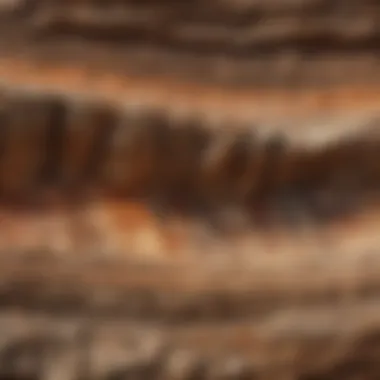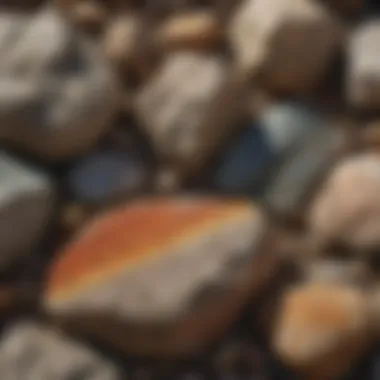Understanding the Diverse Types of Rocks


Intro
Rocks are fundamental to our understanding of the Earth’s history and its processes. They tell a story, a narrative of how our planet has evolved over millions of years. This article seeks to explore the various types of rocks that form the foundation of geological studies. By categorizing these rocks into igneous, sedimentary, and metamorphic, we will highlight their unique formation processes and characteristics. The significance of these rock types extends beyond mere geological interest; they play a crucial role in the landscapes we inhabit and the materials we use in everyday life.
As we delve into this exploration, collectors and enthusiasts will gain insights into each rock type's subcategories, applications, and value. Our aim is to foster a deeper understanding of rocks, enabling readers to appreciate their complexities and importance.
Rock and Fossil Identification
Identifying rocks and fossils is an essential skill for both novice and veteran collectors. Understanding different rock types and their characteristics is crucial. Here, we will discuss the core types of rocks and fossils you may encounter while exploring the natural world.
Types of Rocks and Fossils
- Igneous Rocks: These originate from cooled molten material. Common types include granite and basalt.
- Sedimentary Rocks: Formed through the accumulation and compaction of sediments, examples include limestone and shale.
- Metamorphic Rocks: Created under heat and pressure, common forms include schist and marble.
Fossils, on the other hand, can be categorized into:
- Body Fossils: Actual remains of organisms (bones, teeth).
- Trace Fossils: Signs of activity, such as footprints or burrows.
Characteristics to Look For
When identifying rocks, certain characteristics stand out:
- Color: Provides insight into mineral composition.
- Texture: Indicates the cooling history of igneous rocks.
- Strata: Sedimentary rocks can often be identified by their layered appearance.
- Hardness: Testing with a common mineral like quartz can help determine this.
Tools for Identification
Having the right tools can greatly enhance the identification process:
- Hand Lens: Useful for examining small features closely.
- Rock Hammer: Essential for breaking rocks to examine internal structures.
- Field Guide: A comprehensive reference is invaluable in the field.
"Understanding the characteristics of rocks is the key to successful identification and collection."
Collecting Tips and Techniques
Engaging in rock collecting can be rewarding but requires attention to best practices. Whether you are venturing into hills or riverbeds, knowing how to collect responsibly is crucial.
Best Practices for Collecting
- Research: Understand local regulations concerning rock collection.
- Respect Nature: Avoid overexploitation of sites.
- Leave No Trace: Clean up after your visits.
Locating Prime Collecting Sites
Certain locations are known for exceptional rock and fossil finds. Reach out to local geological groups or join online communities like reddit.com for tips on fruitful areas. Popular locations may include:
- Quarries
- Riverbanks
- Cliff sides
How to Safely Extract Specimens
Extracting specimens requires skill:
- Use a rock hammer carefully to minimize damage.
- Wear protective gear like gloves and goggles.
- Always assess the stability of the rock before extraction.
Preservation and Display
Once you have collected rocks and fossils, proper preservation ensures they can be enjoyed for years.
Techniques for Preserving Rocks and Fossils
- Cleaning: Remove dirt gently using water and a soft brush.
- Resin Coating: Some collectors apply a thin resin layer for durability.
Proper Storage Methods
Consider the following:
- Use acid-free boxes for long-term storage.
- Avoid exposure to sunlight, which can cause fading.
Creative Display Ideas
Displaying your collection can enhance appreciation:
- Shadow Boxes: Great for showcasing both fossils and rocks together.
- Glass Shelves: Allow for open viewing while keeping dust at bay.
Geological Insights
Understanding the geological context of rocks expands appreciation for their significance.
Geological Formations and Processes
Various processes, such as volcanic activity and sedimentation, lead to different rock formations. Learning these processes invites deeper inquiry into the Earth's workings.


Historical Significance of Rocks and Fossils
Each rock or fossil can provide clues about our planet's history. Notable findings contribute to scientific knowledge and sometimes even reshape our understanding of biological evolution.
Notable Discoveries in the Field
Engaging with historical discoveries can be quite enriching. For instance, the discovery of the Burgess Shale fossil site reshaped our understanding of early life on Earth, emphasizing the need for continued exploration and study.
In summarizing the complexities and varieties of rocks, it is clear that they hold immense value both scientifically and personally. Understanding their formation and characteristics is essential for collectors and enthusiasts who seek to connect with the Earth’s history. Through this exploration, we hope to encourage further engagement with the geological world.
Prologue to Rocks
Understanding rocks is fundamental to geological science. Rocks are more than just the material beneath our feet; they tell the story of the Earth’s history, its processes, and its resources. Their study allows us to connect various scientific disciplines, including chemistry, physics, and environmental studies.
In this section, we explore the basic definition of rocks and emphasize their importance in various fields of study.
Definition of Rocks
Rocks are solid aggregates composed of one or more minerals or mineraloids. They can form through geological processes such as volcanic activity, sedimentation, and metamorphism. The composition, texture, and structure can vary widely, giving rise to diverse rock types, each with unique characteristics. A rock can be anything from a small pebble to a massive mountain, demonstrating the extensive range this definition encompasses.
Importance of Studying Rocks
The study of rocks holds significance in several areas:
- Natural Resource Exploration: Many natural resources, including metals, coal, and petroleum, are found in rocks. Understanding their formation helps in exploration and extraction.
- Environmental Awareness: Analyzing rocks can inform us about climate change and the Earth’s history, helping predict future environmental conditions.
- Geological Hazards: Knowledge about rock types and formations can aid in understanding geological processes, potentially forecasting earthquakes and volcanic eruptions.
"Rocks are the key to unlocking Earth's history, offering insights that shape our understanding of the planet."
In summary, understanding rocks is vital not only for geological sciences but also for fields such as resource management and environmental studies. This foundational knowledge sets the stage for deeper exploration into specific types of rocks and their implications.
Classification of Rocks
Classifying rocks is a foundational step in geology, crucial for understanding Earth's processes and structure. The classification of rocks allows for an organized analysis of their origin, composition, and characteristics. By sorting rocks into categories, researchers and enthusiasts can better communicate their findings, share knowledge, and comprehend the geological history they reveal. This structured approach also aids in identifying possible applications of certain rock types in fields such as construction, landscaping, and even art.
Furthermore, classification facilitates a deeper comprehension of the interplay between Earth's systems. Understanding how different rock types form and transform informs us about tectonic movement, sedimentation processes, and environmental changes over time.
Overview of Rock Classification
Rocks are primarily classified based on their formation processes: igneous, sedimentary, and metamorphic. This basic classification provides a framework for understanding the complex nature of rocks.
- Igneous Rocks form from the solidification of molten material. They occur when magma cools, either underground or on the surface, resulting in distinct textures and mineral compositions.
- Sedimentary Rocks develop from the accumulation of sediment through processes such as weathering, erosion, and lithification. They often contain fossils and provide insights into past environments and biological activity.
- Metamorphic Rocks arise when existing rock types undergo alteration due to high pressure, temperature, or chemically active fluids. This process transforms their mineralogy and texture, revealing conditions deep within the Earth’s crust.
These classifications are not only essential for academic study but also inform practical application in various industries. They guide resource exploration, help in predicting geological hazards, and foster appreciation for the natural world among rock and fossil collectors.
The Three Main Types of Rocks
The three main rock types—igneous, sedimentary, and metamorphic—serve as primary categories that encompass a wide variety of subtypes. Each group has unique characteristics that inform their formation and application:
- Igneous Rocks
- Sedimentary Rocks
- Metamorphic Rocks
- Intrusive Igneous Rocks: Form when magma cools slowly below the Earth's surface, leading to coarse-grained textures. Granite is a familiar example of this type.
- Extrusive Igneous Rocks: Created when lava erupts at the surface and cools quickly, resulting in fine-grained textures. Common examples include basalt and pumice.
- Clastic Sedimentary Rocks: Formed from fragments of other rocks that have been cemented together. Examples are sandstone and shale.
- Chemical Sedimentary Rocks: Created through precipitation of minerals from water. Limestone is an example, often derived from biological processes as well.
- Organic Sedimentary Rocks: Made from the accumulation of organic material, such as plant debris or animal remains. Coal is a well-known organic sedimentary rock.
- Foliated Metamorphic Rocks: Characterized by layers or bands due to the alignment of minerals under directional pressure. Schist and slate fall into this category.
- Non-foliated Metamorphic Rocks: These rocks do not exhibit layering and are composed of interlocking crystals. Marble, formed from limestone, is a prime example.
Understanding these types of rocks not only enhances the study of geology but also enriches the enthusiasm of rock collectors who seek to appreciate the diversity and history etched into each specimen.
Igneous Rocks
Igneous rocks hold a significant place in geological studies. They are fundamental to understanding the Earth's processes and contribute to our knowledge of how minerals form and evolve. The two methods of formation—intrusive and extrusive—reflect varying conditions under which these rocks develop. Appreciating igneous rocks is essential for both rock collectors and geologists alike.
Formation of Igneous Rocks
Igneous rocks are formed from the cooling and solidification of molten material called magma or lava. This process can occur in two main settings. When magma cools slowly beneath the Earth's surface, intrusive igneous rocks form. Conversely, when lava cools rapidly on the Earth's surface following a volcanic eruption, extrusive igneous rocks develop. The cooling rate plays a crucial role in determining the texture and composition of the resulting rocks.
Types of Igneous Rocks
There are two major categories of igneous rocks, each with distinct characteristics and formations.
Intrusive Igneous Rocks
Intrusive igneous rocks, also known as plutonic rocks, form from magma that collects deep within the Earth. Due to the slow cooling process, these rocks usually have large, well-formed crystals, which are a key characteristic. Granit is a prime example of an intrusive igneous rock and is commonly used in construction and monuments. One unique feature of intrusive rocks is their ability to form large formations known as batholiths, which can create significant geological landmarks. This characteristic makes them particularly interesting for collectors and enthusiasts.
Extrusive Igneous Rocks
Extrusive igneous rocks, or volcanic rocks, are produced from lava that cools rapidly following a volcanic eruption. Their fast cooling rate results in a fine-grained texture, as crystalline structures do not have much time to form. A popular example is basalt, commonly found in oceanic crusts. The unique feature of extrusive rocks is their association with volcanic activity, which can provide insights into the geological history of a region. However, their fine grain can make them less visually appealing for some collectors compared to intrusive rocks.
Characteristics of Igneous Rocks


Igneous rocks can be distinguished by several traits, including texture, color, and mineral composition. The texture varies from coarse to fine depending on the cooling rate, with intrusive rocks typically displaying a coarser, more crystalline structure. The color can range broadly, from light-colored granites to dark basalts. The presence of minerals like quartz, feldspar, and mica is also crucial in identifying these rocks. Therefore, recognizing these characteristics can greatly enhance a collector's ability to evaluate and appreciate their collection.
Significance of Igneous Rocks
Igneous rocks not only provide insights into geological processes but also contribute to various industries. They are used in construction, for countertops, and as aggregates in concrete. Their durability and aesthetic appeal make them popular for decorative elements. Moreover, understanding igneous rocks can offer valuable information about Earth's history and the dynamic processes that shape our planet. Collecting these rocks also serves to connect individuals with natural history and geological sciences.
"Igneous rocks are the foundational blocks of Earth’s crust, and understanding them is crucial for grasping the planet's geological evolution."
Understanding igneous rocks provides essential knowledge for both collectors and professionals alike, enriching the appreciation of Earth's complex landscape.
Sedimentary Rocks
Sedimentary rocks are a vital component of our geological framework. Understanding them provides insights into Earth’s history, climate changes, and biological processes from millions of years ago. They are formed through the accumulation and cementation of sediments, which include minerals, organic matter, and fragments from other rocks. The study of sedimentary rocks is useful for several reasons: they offer clues into past environments, indicate the processes that shaped the Earth’s surface, and have important implications in fields such as paleontology, archaeology, and natural resource exploration.
Formation of Sedimentary Rocks
Sedimentary rocks form through various processes. First, physical and chemical weathering breaks down pre-existing rocks into smaller particles. These particles are then transported by water, wind, or ice. Once they settle in a basin, they accumulate and eventually become compacted. This compaction leads to lithification, where cementation occurs, binding the sediments together into solid rock. It is important to note the role of time in this process; many sedimentary rocks require hundreds to thousands of years to form.
Types of Sedimentary Rocks
Sedimentary rocks can be categorized into three main types: clastic, chemical, and organic.
Clastic Sedimentary Rocks
Clastic sedimentary rocks are formed from fragments of other rocks and minerals. They are classified by the size of their particles, ranging from fine silt to coarse gravel. One key characteristic of clastic sedimentary rocks is their layered appearance, which provides important information about the depositional environment. For collectors, clastic rocks like sandstone or shale can be a beneficial choice due to their prevalence and variety. However, their weaknesses include porosity, which can affect their structural integrity if not properly handled.
Chemical Sedimentary Rocks
Chemical sedimentary rocks form through the precipitation of minerals from solution in water. Common examples include limestone and rock salt. One standout feature of chemical sedimentary rocks is their often intricate crystal structures and uniform textures. This makes them particularly appealing to rock collectors and geologists alike. Yet, their formation conditions need to be just right; changes in environmental factors can hinder their development.
Organic Sedimentary Rocks
Organic sedimentary rocks, like coal, form from the accumulation of plant and animal debris. A key characteristic is their organic origin, highlighting ancient biological processes. This type of rock is popular among collectors because it connects them to significant ecological histories. However, they can be more sensitive to environmental degradation and mining practices, making their preservation crucial.
Characteristics of Sedimentary Rocks
Sedimentary rocks exhibit several distinguishing features. They are usually softer than igneous and metamorphic rocks, allowing for easier erosion and weathering. Their stratification can reveal layers of history, with different layers corresponding to various time periods or environmental conditions. Sedimentary rocks also have varied colors due to the minerals contained within them. Most importantly for collectors, they often contain fossils that provide significant insights into past life on Earth.
Significance of Sedimentary Rocks
The significance of sedimentary rocks extends beyond aesthetics or practical uses. They serve as key indicators of past environments and climates, helping scientists decipher historical events and changes on Earth. Additionally, sedimentary rocks can act as reservoirs for oil, gas, and groundwater, making them crucial for energy and resource exploration. Thus, their study is essential for understanding both Earth's history and current resource management.
Understanding sedimentary rocks helps in appreciating not only the physical planet we live on but also the historical narratives coded within its layers.
Metamorphic Rocks
Metamorphic rocks represent a significant class of rocks within the geological context, characterized by their transformative processes. These rocks undergo a metamorphic process, which is a result of changes in temperature, pressure, and mineralogical composition. Understanding metamorphic rocks is essential for grasping how geological processes shape our planet’s crust. Their formation reflects the dynamic history of Earth's lithosphere, making them a valuable focus for both scientific study and rock collections.
Formation of Metamorphic Rocks
Metamorphic rocks form when existing rocks, known as protoliths, experience conditions that alter their mineral structure without the rock melting. This process can happen due to:
- Increased pressure: Often occurring in areas of tectonic activity.
- Increased temperature: Typically found with depth in the Earth’s crust.
- Chemical activity: The presence of fluids can facilitate chemical reactions.
These changing conditions lead to lithological transformations, producing rocks with distinct mineral compositions and textures. The rate at which metamorphic processes occur can vary, influencing the final characteristics of the metamorphic rock.
Types of Metamorphic Rocks
Metamorphic rocks can be broadly categorized into two types based on texture: foliated and non-foliated.
Foliated Metamorphic Rocks
Foliated metamorphic rocks are marked by their layered appearance, which arises from the alignment of platy minerals under directed pressure. Common examples include schist and gneiss.
- Key Characteristic: The layered structure of foliated rocks allows for easy identification and contributes to their aesthetic appeal for collectors.
- Contribution to Overall Topic: Their formation under specific directional pressures makes foliated rocks a helpful subject for understanding metamorphic processes.
- Unique Feature: The distinct foliation can demonstrate the history of tectonic forces, providing insights into geological events.
Non-foliated Metamorphic Rocks
Non-foliated metamorphic rocks, in contrast, lack a banded or layered structure. They consist mainly of mineral crystals that have grown and recrystallized in a mass or granular form. Marble and quartzite are prime examples of non-foliated rocks.
- Key Characteristic: The absence of foliation leads to a more uniform appearance, appealing to collectors looking for unique textures.
- Contribution to Overall Topic: Non-foliated rocks are formed under isotropic conditions, making them crucial for understanding different metamorphic environments.
- Unique Feature: Their homogeneity can display specific mineral compositions, revealing the protolith's characteristics and the conditions during metamorphism, thus enriching the study of rock types.
Characteristics of Metamorphic Rocks
The characteristics of metamorphic rocks are diverse and notable. They often exhibit:
- Texture: Can be either foliated or non-foliated based on the metamorphic conditions.
- Mineral Composition: Varies widely and is influenced by the protolith and the conditions of metamorphism.
- Durability: Many metamorphic rocks are more durable than their protoliths, making them valuable for construction.
Significance of Metamorphic Rocks


Metamorphic rocks play a vital role in understanding Earth's history and processes. They can be indicators of past geothermal conditions and tectonic activities.
- Geological Insights: Studying these rocks helps geologists understand the temperature and pressure conditions of the Earth's crust.
- Natural Resources: Some metamorphic rocks, such as marble, are important for architectural and artistic purposes.
"Metamorphic rocks offer a window into the dynamic processes that shape the Earth, providing critical data for both geological research and practical applications."
By examining metamorphic rocks, both enthusiasts and professionals can deepen their knowledge of geologic processes, enhance their collections, and appreciate the complexities of Earth's crust.
Rock Cycle
The rock cycle is a fundamental concept in geology, illustrating the continuous transformation of rock types over time. This section delves into the importance of the rock cycle within the context of our exploration of rock types. Understanding it reveals how igneous, sedimentary, and metamorphic rocks intermingle, forming a complex network of geological processes that sustain Earth’s landscapes.
The rock cycle emphasizes the dynamic nature of rocks, showing that they are not static entities but rather parts of a larger system. This recognition is crucial for rock and fossil collectors as they appreciate the lifelong journey of rocks, from formation to erosion and back again. By studying the rock cycle, collectors can relate their findings to the profound geological processes that shaped them, enhancing their understanding of each specimen.
Understanding the Rock Cycle
In essence, the rock cycle describes how rocks are formed, broken down, and reformed. The cycle comprises several stages:
- Igneous Rocks: Formed from molten magma that cools and solidifies, either below the surface as intrusive rocks or above as extrusive rocks.
- Weathering and Erosion: Natural forces like wind and water erode these rocks into smaller particles and sediments.
- Sedimentary Rocks: These sediments accumulate over time, compressing and cementing into sedimentary rocks.
- Metamorphic Rocks: Through heat and pressure, sedimentary rocks may change into metamorphic rocks, altering their structure and composition.
- Melting: Eventually, all rock types can melt back into magma, restarting the cycle.
This cycling illustrates the interrelationship among different rock types, helping collectors identify rocks in terms of their history and formation processes. It encourages a deeper appreciation for the materials they collect and underscores the interconnectedness of Earth's geological systems.
The Interconnection of Rock Types
The interconnection of rock types within the rock cycle is pivotal for understanding geological processes. Each type of rock plays a specific role in the cycle, which not only governs rock formation but also impacts ecosystems and human activities.
- Igneous to Sedimentary: When igneous rocks undergo weathering, they contribute to sediment formation, which can lead to the creation of sedimentary rocks.
- Sedimentary to Metamorphic: As sedimentary rocks are subjected to heat and pressure, they may be transformed into metamorphic rocks, introducing new minerals and textures.
- Metamorphic to Igneous: With sufficient heat, metamorphic rocks can melt back into magma, completing the cycle.
This interplay fosters geological diversity and complexity within the landscape. Understanding the rock cycle is especially important for collectors. It allows them to appreciate the journey their specimens have taken through time.
"The rock cycle is not just a path; it embodies the history of our planet."
Through this lens, collectors can view their finds with a sense of context, aware that each rock carries a unique story shaped by both natural and temporal forces.
Collecting Rocks
Rock collecting is not just a hobby; it is a pursuit that opens up perspectives on our planet's history, geology, and beauty. Enthusiasts engage in this practice for multiple reasons, including aesthetic appreciation, scientific study, and educational purposes. Collecting rocks allows individuals to connect with the geological processes that shape our Earth. Moreover, it fosters an understanding of diverse rock types and their formations, which enhances one's knowledge about natural landscapes and ecosystems.
As collectors delve into this fascinating world, they discover the benefits of engaging with local geology. Each rock collected tells a story about a specific period in Earth's history. The tactile experience of examining different textures or colors deepens the appreciation for natural materials and their unique characteristics. This hands-on engagement creates a lasting connection to the environment and encourages a more profound respect for Earth’s resources.
Despite the joys of collecting rocks, certain considerations must be taken into account. It is essential to approach rock collecting with responsibility and awareness, adhering to ethical standards that respect nature and local regulations. Some locations may have specific laws governing the removal of rocks, especially in protected areas.
"Collecting rocks responsibly not only preserves natural beauty but helps maintain ecosystems."
Being mindful of the environment while pursuing this passion is crucial for the longevity of this activity.
Ethics of Rock Collecting
The ethics of rock collecting revolve around sustainability and respect for the environment. Collectors should consider the impact of their actions on ecosystems and biodiversity. It is important to understand that some locations are not suitable for collecting, especially if they are home to rare or endangered species.
Here are several ethical practices to adopt:
- Research Local Laws: Before collecting, determine whether it is legal to do so in the area. Many national parks and conservation areas prohibit removing rocks or minerals.
- Leave No Trace: When collecting, ensure minimal disturbance to the habitat. Avoid damaging surrounding plants or soil, which can lead to erosion.
- Take Only What You Need: Collecting should be for personal enrichment, not excessive hoarding. This practice guarantees that future generations can enjoy these natural resources.
- Educate Yourself: Understanding the geological significance of what you collect can increase appreciation and encourage responsible stewardship of natural spaces.
By adhering to these ethical practices, collectors can enjoy their passion while protecting the environments they explore.
Resources for Rock Collectors
Numerous resources can help rock collectors enhance their knowledge and skills. These include books, websites, and community forums where enthusiasts share experiences and tips. Here are a few notable resources:
- Books: Consider guides like "Rocks and Minerals" by Chris Pellant for basic identification and collecting tips.
- Websites: The Wikipedia page on rocks provides in-depth information about different types and formation processes.
- Community Forums: Websites such as Reddit host forums for collectors to ask questions and exchange information about techniques and local sites.
- Field Guides: Regional field guides offer in-depth knowledge about local geology, identifying specific rock types and their locations.
- Local Clubs: Joining a rock collecting club can provide mentorship opportunities and hands-on experiences with seasoned collectors.
By making use of these resources, collectors can deepen their understanding of geology and enhance their collecting endeavors.
Finale
The conclusion of this article serves as a pivotal point for readers, encapsulating the essence of what has been explored regarding rock types. It highlights the importance of understanding the diverse classifications of rocks—igneous, sedimentary, and metamorphic—and their distinct characteristics. This knowledge is not only vital for academic and geological pursuits but also of significant value to rock and fossil collectors who seek to expand their understanding and appreciation of natural materials.
Recap of Rock Types and Their Significance
Throughout this article, we have dissected the fundamental aspects of the three main types of rocks. Igneous rocks, formed from cooling magma or lava, can be either intrusive, like granite, or extrusive, such as basalt. They reveal much about Earth's internal processes and have numerous uses in construction and design.
Sedimentary rocks are crucial in interpreting Earth's history. Their formation through the accumulation of sediments provides insights into past environments and ecosystems. Types like limestone and sandstone not only hold geological significance but also serve practical applications, including resource extraction and landscaping.
Metamorphic rocks, arising from the alteration of existing rocks under pressure and heat, demonstrate the dynamic nature of geological processes. Rocks like schist or marble illustrate the transformative power of the Earth. Collectors often favor these for their unique textures and aesthetic appeal.
Ultimately, understanding these rock types and their significance enriches one’s knowledge of Earth’s history and composition, which is pivotal for geologists and collectors alike.
Future Perspectives in Rock Studies
The realm of rock studies continues to evolve, offering new perspectives and techniques for both research and collection. Advances in technology, such as geochemical analysis, allow researchers to uncover the mineral compositions of rocks with greater precision. This leads to an improved understanding of geological processes and enhances the ability of collectors to identify and value specimens accurately.
Sustainability and ethical considerations in rock collecting are also gaining prominence. It is vital for collectors to remain mindful of their impact on natural ecosystems. The ongoing discourse about conservation practices may influence collecting habits in the future, driving a greater appreciation for responsible collecting.
Furthermore, educational resources, such as online forums and platforms like Reddit, are emerging as valuable spaces for enthusiasts and professionals alike to share knowledge and experience. Engaging in these communities fosters a more inclusive atmosphere for learning, significantly benefiting both new and seasoned collectors.
By appreciating the profound connections between rocks and their environments, future studies can deepen our understanding of the Earth and inspire a new generation of enthusiasts and collectors.







